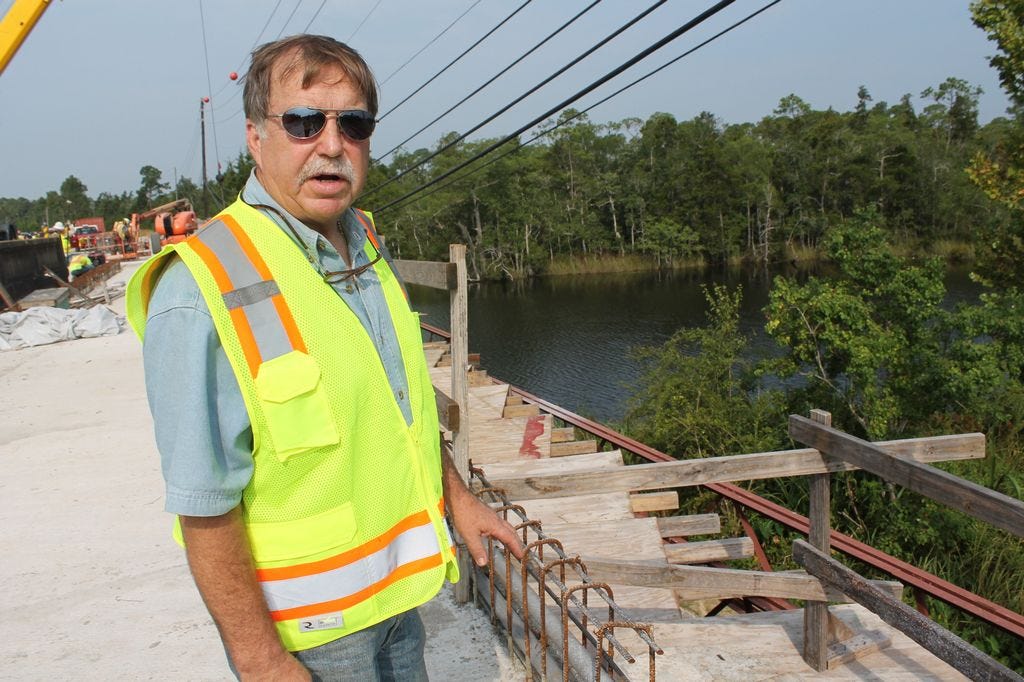
Concerns regarding the additional funds used in the ongoing construction of the MarquisBayouBridge, originally finished in 1937, came before Milton’s elected officials Tuesday night, during the city’s regular council meeting. Councilmember Jimmy Messick, also serving as the city’s Transportation Planning Organization (TPO) representative, provided the council with information he acquired from Peggy Kelley, project manager with the Florida Department of Transportation (FDOT), the governmental agency overseeing the construction of the new bridge. Messick said the redesign costs for the bridge of $850,000 and the increased construction costs of $3,700, 000 totaled $4,500,000. Santa Rosa County Commissioner Bob Cole and Santa Rosa Historical Society President Vernon Compton defended the redesign saying it maintained the historic nature of the entrance to Milton’s historic district.
Messick said he inquired about the cost and time spent on the bridge after reading a recently published article in the Santa Rosa Press Gazette. In the article, Cole stated he consulted with the Santa Rosa Historical Society (SRHS) on preserving historical significance of the bridge. Tuesday, Messick said, “The initial estimated cost was $3.5 million and…the final estimated cost is $7.2 million. That is a $4.5 million dollar increase, which is due to the changes asked for by the historical (society)…While the public is served all the touchy feely information related to preserving the historic nature, I think you should also be furnished the cold hard facts about the costs related to it.”
Cole and Compton defended the redesign. Cole said, “I supported that 100 percent because we too often miss the craftsmanship you see in older construction compared to today.” He said he wanted to maintain the classic style “especially being the eastern entrance (to the city).”
Compton said the original goal of the SRHS and Main StreetMilton, the downtown Milton revitalization nonprofit sharing many members with the SRHS, was to rehabilitate the original bridge. “Other communities have done that,” he said. “I think DOT looked at that and said they could not save the bridge. It had to come down and be replaced…(Once) we understood it couldn't be saved then we advocated for this. (The bridge) is a gateway to the historic district in downtown Milton. Instead of what we called an ‘any place in America bridge,’ we advocated for one that represented the historic nature of original bridge and heritage of this area.”
Regarding the added expenses, Compton said, “Yes, we recognize the additional cost but we also feel these are federal aid projects. We feel like (SRC) is deserving of that. We deserve some of that good infrastructure for cars, bicycles, and pedestrians.” As to the process of getting to this point, Compton said it was all public. “DOT was upfront throughout the process. There was no surprise to the City of Milton and no surprise to the parties involved. We engaged with DOT at public meetings, the same process involved as always with public engagement.” Compton said the SRHS and MSM did not affect these changes, only advocated for them.
Messick said a majority of the added cost came from constructing an acrow bridge for temporary use to allow engineers to work on the bridge. “That is what has increased the cost from $3.5 million to $7.2 million,” he said. Kelley confirmed the email correspondence with Messick to the Press Gazette, in which Messick inquired if the acrow bridge would have been necessary if not for the inclusion of the railings. “If we could have built the new bridge to the south of the existing bridge as originally planned and utilized the existing bridge while the new bridge was being built, the acrow bridge, detour equipment, generator usage, etc, would have not been needed,” Kelley said.
Kelly said, “Because the historical group would not allow the new bridge to go in as FDOT planned, everything related to the new bridge had to be redesigned to meet the new location and requirements that the historical group was pressing for (i.e. railings, using the same footprint of the old bridge, etc.).” In the same email, Messick inquired how much extra time the changes added to the construction, to which Kelley said the FDOT has been working on the project for the past five years.
According to Kelley, the $850,000 redesign costs come from Section 106 of the National Historic Preservation Act of 1966. Section 106 requires federal agencies to take into account the effects of the undertakings on historic properties. In the case of the MarquisBayouBridge, this preservation resulted from the historical groups working with State Historic Preservation Office (SHPO) and the Federal Highway Association (FHWA). Kelley said the historical groups along with SHPO and FHWA led the FDOT to put the bridge project under Section 106 consultation, where the project resides to this day.
Compton said, “Our mission is to preserve history and historic buildings and places in (SRC). This was not a SRHS or MSM requirement but federal law,” referring to Section 106.
Former Mayor Guy Thompson said the changes to the bridge design and associated costs never came before the TPO during his time of service. He said he only found out these additional costs last month. “I think it’s an absurd waste of taxpayers’ money.” He said the additional dollars could have paid for a sister bridge if FDOT four-lanes Highway 90 through downtown or any other transportation project in SRC.
This article originally appeared on Santa Rosa Press Gazette: Historic elements add to bridge cost extra $4 mil
